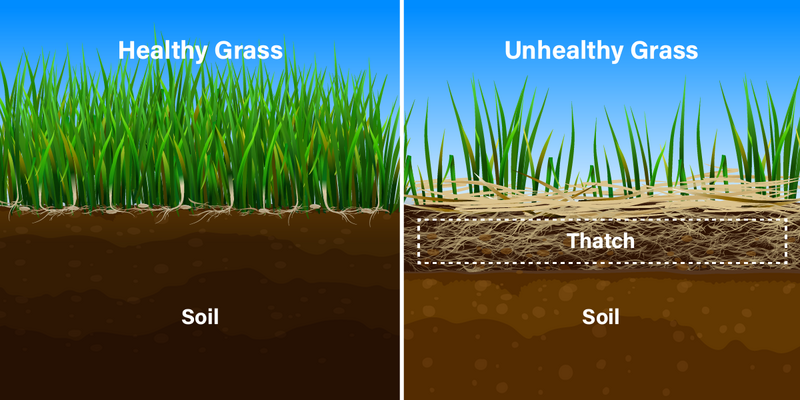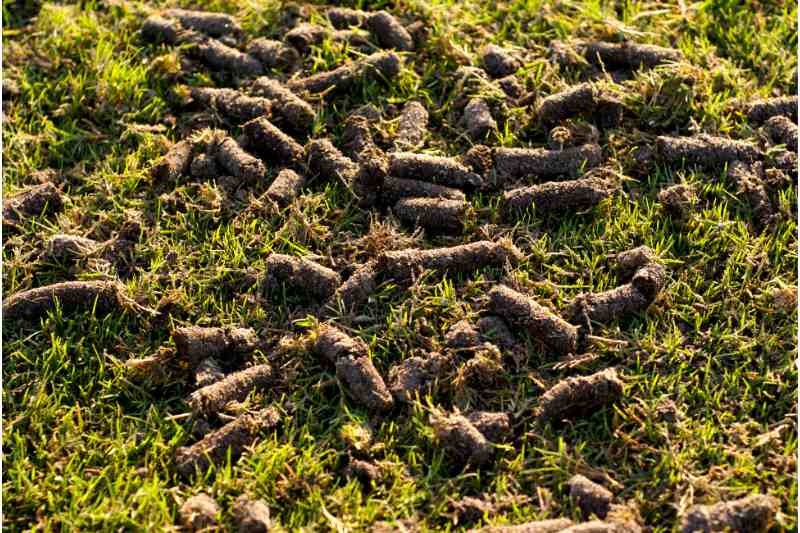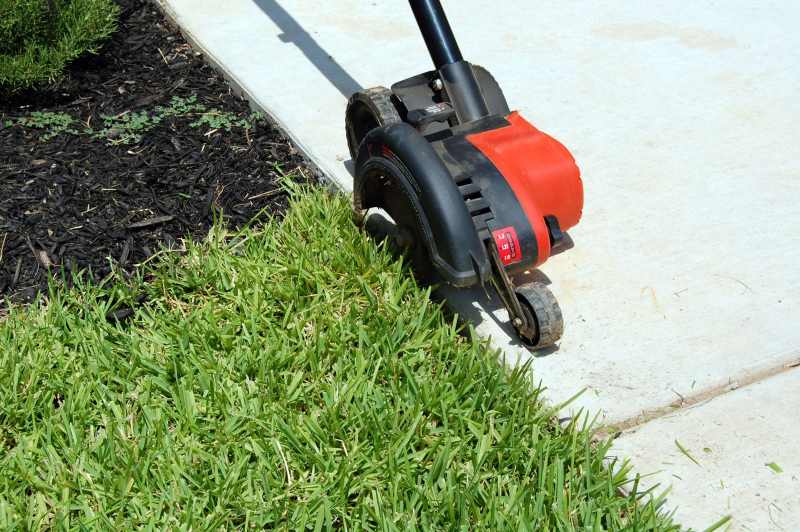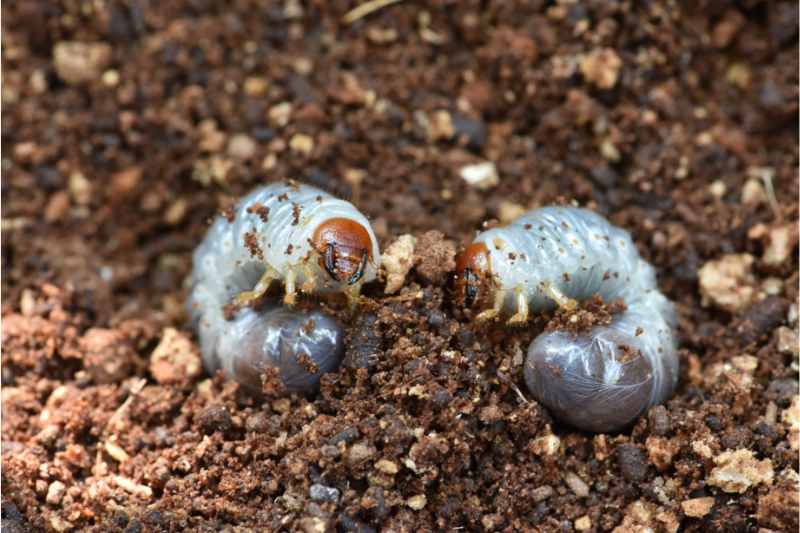
The arrival of spring brings more than just beautiful blooms; it also signals the start of the lawn care season. Your grass is quite tender as it wakes up from winter dormancy, so it’s important to start off your lawn maintenance the right way. In over your head? Don’t worry; here are some spring lawn care tips to help you during this crucial period.
- Clean up your lawn
- Dethatch
- Aerate … if necessary
- Do a soil test
- Deal with lawn weeds
- Overseed bare patches
- Fertilize your lawn
- Top off your mulch
- Inspect your tools
- Check your sprinkler system
- Mow properly
- Edge your lawn and beds
- Water wisely
- Keep an eye out for pests
- Treat lawn diseases
- FAQs about spring lawn care
Clean up your lawn
The first thing to tick off of your spring lawn care list is cleaning up your yard. Most of the debris in your yard will probably be some form of plant matter – leaves, twigs, and the like – that dried up and died. You’ll want to grab a leaf rake or a leaf blower and clear the area. Don’t throw them away either; you can chuck green waste (minus weeds) into your compost pile for free material.
While you should be gentle when raking your grass, don’t be afraid to get into it if you find grass blades that have matted together. Caused by snow molds, excessive watering, and compacted soil, matted grass can prevent new grass from sprouting. Don’t add diseased grass to your compost pile if you pull any up.
Avoid raking if it has recently rained. You don’t want to rake muddy soil as you might uproot healthy grass along with the dead grass.
Dethatch

Thatch is the spongy layer of dead and living organic matter — think roots and leaves — between your turf and the soil. While thatch can be healthy in small amounts, thatch thicker than ½ inch can cause problems in your lawn. If your lawn has a thick layer of thatch, then you’ll need to dethatch it. To check how thick your lawn thatch is, you’ll need to dig up 3-inch-deep soil samples and measure the thickness of the spongy layer.
When should you dethatch? You’ll want to dethatch your lawn during your turf’s growing season so they won’t be as stressed and can recover easily from damage.
- Warm-season grasses: Dethatch grasses like Zoysia, St. Augustine, Bermuda, and bahia in late spring.
- Cool-season grasses: The ideal time to dethatch grasses like fescues, Kentucky bluegrass, and perennial ryegrass is in the fall, but it can be done in very early spring.
You can dethatch your lawn DIY with a dethatching rake, a dethatcher, or a verticutter. You may have even removed some thatch while raking your lawn. If you want to make sure your lawn gets dethatched properly, you should consider hiring a pro.
Aerate … if necessary

ArtBoyMB | Canva Pro | License
If you have compacted soil in your lawn, then your grass will have a harder time growing and getting the nutrients it needs. Lawn aeration (or aerification) is the process of poking holes in your lawn to increase the flow of oxygen, nutrients, and water from the surface to your turf’s root system. There are many benefits to aerating your lawn, such as increasing your lawn’s drought tolerance and fostering beneficial organisms.
While aeration is helpful, not all lawns need to be aerated. However, you might need to do so if your lawn has clay soil and/or if you have a lot of foot traffic on your lawn. Check for any signs that your lawn might need aeration, such as puddle formation after rain or irrigation.
The timing for spring aeration is similar to that of dethatching — and for the same reasons, too.
- Warm-season grasses: Aerate warm-season grasses as they start to grow in late spring.
- Cool-season grasses: The best time of year to aerate is in the fall, but it can be done in very early spring.
Aerating your lawn DIY isn’t difficult, but you can also hire a pro to do it for you.
Do a soil test

Most grasses tend to thrive in soil with a more neutral pH (around 6 to 7), so it’s important to ensure your soil’s pH is within that magic number. There are some signs that can hint as to how your soil is doing; for example, moss and some weeds thrive in acidic soil, while other plants, like some clovers, prefer alkaline soils. However, conducting a soil test will tell you exactly what’s going on — pH, nutrient levels, and much more.
If your soil test report reveals you have very alkaline or very acidic soil, you’ll need to add soil amendments to your lawn to change its pH level. For example, you might need to lime your lawn to raise your soil pH.
Deal with lawn weeds

There are two approaches to weed control: prevention with a pre-emergent and reaction with a post-emergent.
Use a pre-emergent herbicide early in the season to prevent these weeds from germinating:
- Crabgrass
- Spurges
- Prostate knotweed
- Goosegrass
- Purslane
Timing is key with pre-emergent weed killers; applying too early will be ineffective, while applying after weeds have already sprouted is much too late. Keep in mind that pre-emergent herbicides also will affect grass seeds if you are overseeding.
On the other hand, post-emergent herbicides will need to be applied on already-sprouted weeds. It’s better for your lawn and your wallet to spot-treat weeds rather than spraying your whole lawn. There are also other ways to get rid of weeds such as hand-pulling and smothering, but they may not be as effective on perennial weeds like the following:
- Dandelions
- Plantains
- Ground ivy (Creeping Charlie)
- Yellow wood sorrel (oxalis)
- Nutsedge
- Prostate knotweed (perennial in some areas)
- White clover
Do you need herbicides? We’ve reviewed some weed killers and ranked the best ones in these articles:
- Best Weed Killers
- Best Pre-Emergent Herbicides
- Best Post-Emergent Herbicides
- Best Weed and Feeds
- Best Weed Killers for Flower Beds
You also can make homemade weed killer if that’s more up your alley. Is the idea of treating weeds yourself not tickling your fancy? Consider hiring a pro.
Overseed bare patches

Throughout the year, your grass can get damaged by heavy traffic, the environment, lawn diseases, neglect, and urine (if you have pets). A thinning lawn or one with bare spots will lower your curb appeal. If you want to fix that unsightly mess, then you’ll need to overseed your lawn. Overseeding is the process of growing grass seed over already established lawns.
When should you overseed? It depends on where you live.
- Warm-season grasses: Overseed grasses like Zoysia, St. Augustine, Bermuda, and bahia in late spring.
- Cool-season grasses: The ideal time to overseed grasses like fescues, Kentucky bluegrass, and perennial ryegrass is in the fall, but it can be done in early spring if your lawn has a lot of bald spots.
If you plan to dethatch or aerate your lawn this spring, then you should postpone overseeding until after you’ve finished these tasks. If you overseed before dethatching and aeration, then they’ll be disturbed and might not germinate.
Treat your overseeded grass as you would newly planted grass. The most important thing is to keep it moist. How long you’ll need to water your grass seed fluctuates based on how long it’s been since they’ve been planted.
Fertilize your lawn

To recover and grow well this spring, your lawn will need nutrients: nitrogen, phosphorus, and potassium. These three are found in all fertilizers in differing ratios, denoted by the letters “N-P-K”. You will likely need to feed your lawn with a slow-release fertilizer or compost. Don’t go too hard on fertilization, though, especially if you already fertilized last fall; too much fertilizer can actually weaken your turfgrass through excessive growth.
Here are some simple steps to follow when fertilizing your lawn:
- Do a soil test. A soil test will tell you the nutrient levels of your soil and what fertilizer ratio you should use on your lawn.
- Calculate your lawn’s square footage. You can break down your lawn into imaginary shapes: squares, rectangles, circles, and triangles. Then, get the area of each shape in square feet. After that, add everything together.
- Calculate how much fertilizer you need. You should add 1 pound of nitrogen per 1,000 square feet of lawn you have. To do that, you’ll need the N-P-K ratio of the fertilizer you wish to use or what the soil test recommends. Look for the value of “N” and convert it to a decimal, then divide that decimal by 1. That number is how many pounds of fertilizer you’ll need to apply per 1,000 square feet.
- Check the weather. Don’t apply fertilizer if it’s due to rain in two days or less. It’s also not a good idea to fertilize wet grass. If you’re using a liquid fertilizer, don’t fertilize if it’s windy out.
- Use protective gear. Wearing gloves, safety goggles, long pants, long sleeves, and a mask will protect you from nitrogen burns.
- Read the instructions. Some fertilizers have special instructions or restrictions.
- Apply the fertilizer. How you will do this will depend on the type of fertilizer and tool you use. Regardless of the type, you want to spread the fertilizer evenly throughout your lawn. You can start at the perimeter of your lawn and move to the center afterward. Fertilize in a grid-like pattern, starting north to south and then east to west.
- Push excess fertilizer back onto the grass. Using a leaf blower or a broom, get the excess fertilizer back onto your turf.
- Follow post-application instructions. You might need to water your lawn afterward depending on the fertilizer.
A good rule of thumb is to fertilize your lawn three weeks after your grass has started greening up, which will depend on the type of grass you have. However, you’ll need to wait at least a week to fertilize if you used herbicides on your lawn.
Water your lawn a few days before fertilizing, then fertilize lightly. Don’t pile on a heap of fertilizer on your grass; spread it out with a spreader or you’ll risk fertilizer burn.
Top off your mulch

There are many advantages to mulching your lawn and garden, such as preventing soil compaction and weed growth. Overall, mulch is a protective layer for your soil. Spring — particularly early to mid-spring — is the best time of the year to add mulch or top off existing mulch. A 2 to 3-inch layer of mulch should be fine.
The best part about mulch is that organic mulches can supplement your fertilization; as it breaks down, it releases nutrients into the soil. Organic mulch is also one of the easiest mulches you can find for free. Look no further than your own lawn: Grass clippings make excellent mulch.
Here are the organic and inorganic mulch options available:
Organic:
- Leaves
- Tree bark
- Grass clippings
- Pine needles
- Wood chips
- Aged sawdust
- Straw
Inorganic:
- Rocks and gravel
- Landscape tarp
- Landscape fabric
- Metallic mulch
- Rubber mulch
Inspect your tools

Before you start mowing, you need to inspect your lawn mower and prepare it for the new season. Here are some of the best lawn mower maintenance practices you should follow:
- Warm up your lawn mower before starting your lawn mower. Place it under the sun for an hour or so. A cold mower is more difficult to start.
- Start the mower and check if it has any difficulty starting up. Perform a tune-up if it does. Tune up your mower by:
- Gas-powered lawn mower: Change its oil, spark plug, and air filters. Then, fill the fuel tank.
- Battery-powered lawn mower: Check the battery and replace it if it doesn’t hold a full charge anymore.
- Sharpen your mower blades for a clean cut, which is better for your turf’s health. If there are a lot of nicks or if your mower blade won’t sharpen, it’s time to replace it.
- Clean beneath the deck by rinsing with water. Over time, your lawn mower’s deck will get clogged with grass clippings, dirt, and debris.
Some homeowners may have more than just lawn mowers in their lawn care arsenal. Most gas and electric tools have similar parts that you’ll need to check. Here are some lawn care tools and how to maintain them:
- Lawn edger: Inspect for dirt and clean up. Check the engine belts, head, oil, fuel/battery, and air filter; replace if needed. Sharpen the blade if it’s dull.
- String trimmer: Inspect for dirt and clean up. Check the oil, fuel/battery, and air filter; replace if needed. Replace the trimmer line.
- Cutting tools: Sharpen their blades if needed.
Check your sprinkler system

You also need to check your sprinkler system to see if everything is in working order, especially if you experience freezing temperatures in the winter. Let’s walk through what you need to do with your sprinkler system this spring:
- Clean your sprinklers. Clogged sprinklers can sometimes be solved with a thorough brushing or rinsing. A clean sprinkler system will at least rule out debris as the cause of any issues you find.
- Adjust your sprinkler heads. Some of them may be facing the wrong direction. While the exact steps to adjust your sprinkler heads will depend on the type of system you have, you will generally need to turn an adjustment screw for each head.
- Watch for problems. Once you run your sprinkler, look for wild streams of water, runoff, and puddle formation; those are signs of damaged or leaky sprinkler heads. If you find that no water is coming out of your sprinklers, then there might be a problem elsewhere in the system.
- Get repairs done. If your sprinkler system has issues, you can repair them yourself or hire a pro to do it for you.
Mow properly

Eventually, you’ll need to mow your lawn. This is a relatively straightforward process, but there are some lawn mowing tips and tricks you should follow to ensure you don’t hurt your lawn.
- Mow off only 1/3rd of your grass at a time to prevent stressing your grass. Wait until your grass is 50% higher than your ideal height before you bust out your lawn mower for the first mow of the season.
- Mow down to your turf’s ideal height, but try to mow on the higher side of the range to block out weed seeds.
- Don’t mow wet grass, which can clog up your mower.
- Mow in a different pattern every time you mow to prevent a pattern from forming in the grass.
- Overlap a little when mowing to ensure an even cut.
- Start slow. You will likely need to mow every other week early in the season as the grass hasn’t started growing vigorously. As the temperature warms up and your grass begins growing faster, switch to weekly mowing.
- Don’t mow when it’s hot out. The best times for lawn mowing are during the mid-morning or late afternoon.
If you don’t know what your turf’s ideal height is, you can refer to the table below:
| Grass type | Ideal lawn height (inches) | Mow when the grass reaches this height (inches) |
| Bahiagrass | 3.0 – 4.0 | 4.0 – 5.25 |
| Bermudagrass | 1.0 – 2.0 | 1.25 – 2.5 |
| Buffalograss | 2.0 – 4.0 | 2.5 – 5.25 |
| Carpetgrass | 1.0 – 2.0 | 1.25 – 2.5 |
| Centipedegrass | 1.5 – 2.0 | 2.0 – 2.5 |
| Fine fescue | 1.5 – 3 | 2 – 4 |
| Kentucky bluegrass | 2 – 3 | 2.5 – 4 |
| Perennial ryegrass | 2 – 3 | 2.5 – 4 |
| St. Augustinegrass | 2.5 – 4.0 | 3.25 – 5.25 |
| Tall fescue | 2 – 4 | 2.5 – 5.25 |
| Zoysiagrass | 1.0 – 2.5 | 1.25 – 3.25 |
Instead of bagging your clippings, try grasscycling; keep it on your lawn or chuck it into your compost pile or bin. However, it’s not a good idea to use it as compost material if you’ve recently treated your grass with chemicals or if your grass has a lawn disease.
Edge your lawn and beds

Spring is one of the best times to edge your lawn as the early spring soil is much easier to dig into and work with. Edging gives your lawn a crisp, clean look, and it’s not difficult to do. To define an edge, you’ll need a landscape edger or a motorized lawn edger. You can even line the edge with metal, wood, stone, and other materials.
Over the season, you can use a string trimmer to clean up your lawn’s edging when it grows taller.
Water wisely

Lawn irrigation influences your lawn health in more ways than one. While underwatering is obviously bad, you might not know that overwatering can be just as bad – at least in the long run. Overwatering teaches your turf to grow shallow roots as they don’t need to dig deep into the soil to look for water. It also can lead to fungal diseases.
Here are some tips to remember when watering your lawn:
- The best time to water your lawn is between 5 a.m. and 9 a.m. Don’t water when it’s hot out and not when it’s too late in the day.
- Only water when your grass is thirsty. A simple test you can do is to step on your grass. If it doesn’t bounce back and lays flat, it needs watering.
- Water less often during early spring. The cooler temperatures mean that less water evaporates during this period. Spring showers also may help irrigate your lawn.
In the spring, cool-season grasses need 1 to 1.5 inches of water every week, while warm-season grasses need only 1 inch of water weekly.
If you want to know if your system is putting out the right amount of water, run the tuna can test:
- Place tuna cans around your lawn and run your sprinklers for 15 minutes.
- Measure how much water is in each can with a ruler, then average them out.
This handy table can tell you how long you’ll need to run your sprinklers based on the average water depth in the cans:
| Average water depth after 15 minutes | Total minutes needed to water 1 inch |
| ⅛ inch | 120 |
| ¼ inch | 60 |
| ½ inch | 30 |
| ¾ inch | 20 |
| 1 inch | 15 |
Keep an eye out for pests

Many pests can crawl out of the woodwork once spring rolls around. Some common spring lawn pests include sod webworms, ticks, and aphids. However, the most notorious pests to keep an eye out for are grubs, which rear their tiny heads in late spring.
There are many ways to approach pest control, including integrated pest management and organic pest control options. If you find yourself struggling with pests, you might want to contact a pro.
Treat lawn diseases

The cool weather and spring showers can cause many fungal diseases to start popping up on your lawn. Here are some common lawn diseases you might see this spring:
- Fairy ring
- Necrotic ring spot
- Dollar spot
- Snow molds
- Anthracnose
- Leaf spot and melting-out
- Rust
Many of these fungal diseases cause your turf to develop lesions, become discolored, thin out, and die in patches or rings. Some even cause foreign bodies to sprout on your grass, like mushrooms, cobweb-like mycelium, or fruiting bodies.
Most of these diseases can be kept at bay by practicing good lawn management, especially preventing overwatering. If you find your lawn has become diseased, fungicide sprayed by you or a pro will get rid of the fungi.
FAQs about spring lawn care
How can you make your grass greener in the spring?
The main way you can help your grass get greener in the spring is through fertilization. Lawn fertilizer contains nitrogen, phosphorus, and potassium, which are the three major nutrients that grass needs for new growth.
When should you start spring lawn care?
Typically, homeowners should wait until all threat of frost has passed before starting their spring lawn care. Some tasks need to wait until after your grass has started greening up.
If you want a more detailed look at your spring lawn care duties, check out our lawn care calendars:
Is spring a good time to topdress your lawn?
If you have warm-season grass, yes! One of the best times to topdress your warm-season lawn is in late spring. You want to topdress your lawn when it’s actively growing, so it’s better to wait for late fall to topdress your cool-season grass.
Do you need help with your spring lawn care?
Spring is a crucial time for your lawn because it’s the time your turfgrass bounces back from winter dormancy. It’s important that you start off your winter lawn care on the right foot. However, not everyone can exert the time and effort necessary to foster a healthy lawn.
Don’t worry! Lawn Love’s network of pros can help you achieve and maintain the green lawn of your dreams this spring. We can connect you with a capable pro in your area, or you can get a free quote first while you think about it. Hire a pro through Lawn Love today.
Main Image Credit: welcomia | Canva Pro | License